A20: English
The starting point of this investigation by GM Zoltan Ribli
occurs after the moves 1.c4 e5 2.g3 Nf6 3.Bg2 d5 4.cxd5 Nxd5
5.Nf3 Nc6 6.0-0 Nb6 7.d3 Be7 8.Nbd2 0-0 9.a3 a5 10.b3 Be6 11.Bb2
f6 12.Qc2 Qd7
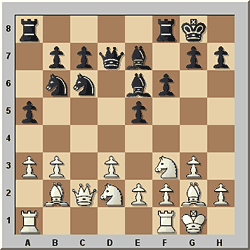
In this position, which is actually a reversed Sicilian Defense,
White has two main continuations: 13.e3 and 13.Rfd1. “Of course,
other moves are possible,” Ribli writes, “for example 13.Rac1,
but this move is of no independent significance. There is quite
an important difference between this position and the Sicilian
Defence. Here White is employing a Sicilian setup with an extra
tempo, so that Black does not find it so easy to (or cannot)
attack on the kingside with f5 –so he must play in the center.
On the other hand White has a very sound position with two
bishops on the long diagonals and possibly (after due
preparation) he can manage to get in the move d3-d4.”
GM Ribli ends his article with the following conclusion: “This
variation, 8.Nbd2, has accumulated less theory than the main
line 8.Nc3. The setup with g3-Bg2 and b3-Bb2 is somewhat
reminiscent of hedgehog positions, in which the opponent also
controls more space. But Black must be careful – if White can
manage to play d3-d4, then it is possible, that with his two
bishops on the long diagonals he is better placed. However, in
general chances are about level.”
B75: Dragon Sicilian
“In the spring of 2005,” writes GM Dorian Rogozenko, “I was
playing in an open tournament in Galati, Romania. There I
witnessed a game, which started with the Pirc move order 1.e4 g6
2.d4 Bg7 3.Nc3 d6 4.Be3 Nd7 5.Qd2 c5. White continued 6.Nf3 cxd4
7.Nxd4 Ngf6 8.f3 and the game suddenly transposed into a strange
Dragon Sicilian, where Black had developed the knight on d7
instead of the usual square c6:
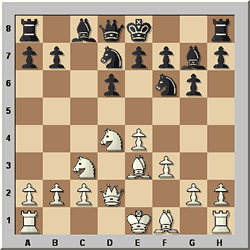
Looking at the board at that moment, I was trying to recall if I
had ever seen anything like this in the Dragon. I could vaguely
recall Kasparov,G-Georgiev,K, 1-0, in Sarajevo 2000, and a bit
more clearly Botvinnik’s conclusion from his own book. Since I
had never considered such a set-up in the Dragon to be serious,
I felt happy for the player with the White pieces. However, in
Ionica,I-Bogdan,D, 0-1, Galati 2005, White castled long and then
advanced her kingside pawns (apparently a totally logical step
in the Dragon). However, the battle lasted for less than 25
moves – White was completely crushed. In the post-mortem
analysis several IMs failed to figure out where White went wrong
and what was the cause of such a quick defeat...
In the present survey we will analyse this unusual Dragon and
see what the best plans are for White and for Black. But before
looking at ideas and concrete variations, I’ll say a few brief
words about the history of the variation being examined. It
occurred for the first time in 1945 in a game of Alexander
Alekhine. However, the 4th World Champion soon implemented the
plan with ...Nc6 and ...Bd7, which has nothing to do with the
specifics of this line. In the beginning of the 1960s Mikhail
Botvinnik used Black’s set-up in two games. Botvinnik himself
considered that the entire idea of Black’s queenside development
belongs to Reshevsky, who played so in 1957. After Botvinnik’s
games, the present system wasn’t used by strong players for many
decades and therefore theoretical sources don’t really analyse
it. In fact, there is practically no theory at all.
In 2004 several British players, including the Dragon expert Ch.
Ward, implemented the plan with ...a6 and ...Nbd7. But the
revival happened at the end of 2005 during the World Cup in
Khanty-Mansiysk, when first Khalifman and then Sakaev won two
very important games with Black. After Khanty-Mansiysk, GMs J.
Ehlvest, A. Fedorov and S. Kudrin started to play this system as
well, the last two of them being well-known Dragon experts.”
The variation that GM Rogozenko looks at, starts with the moves
1.e4 c5 2.Nf3 d6 3.d4 cxd4 4.Nxd4 Nf6 5.Nc3 g6 6.Be3 Bg7 7.f3 a6
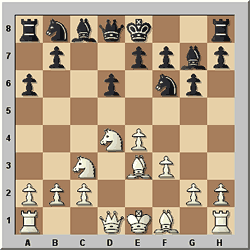
Rogozenko: “Unlike in the traditional Dragon, here Black plans
to continue with b7-b5, develop the bishop to b7 and the queen’s
knight to d7. Then the second player should act according to
circumstances. Usually the rook goes to c8, building up activity
along the c-file (including ideas of an exchange sacrifice on
c3). Generally Black’s play in this system is quite easy, since
his next 3-4 moves are often the same, no matter what White’s
plan may be.
The first player has a larger variety of ideas. The standard
plan in the Dragon with Qd2, 0-0-0 and an eventual exchange of
dark-squared bishops on h6 is strong here as well, even if there
are some specific subtleties for this concrete variation. The
main difference is that here Black delays castling short and
thus White cannot develop a quick attack on the kingside.
Another thing is that the inclusion of the moves h4/h5 almost
always favours Black.
Besides castling long, White also has ideas about play on the
queenside thanks to the fact that the black pawn on b5 offers
White active possibilities connected with a2-a4. In that case
White will castle short and simply enjoy a strategic advantage
due to Black’s weak pawn structure. Notice that this plan is
usually effective with the white light-squared bishop on the
diagonal f1-a6. With White’s bishop on b3 the advance a2-a4 is
less dangerous for Black. Needless to say, after White has
castled long, the move a2-a4 loses its attractiveness. Also with
the king on e1 the advance a2-a4 can have its drawbacks when
White already made pawn advances on the kingside (such as g2-g4
and/or h2-h4), after which he might have problems finding a safe
place for his king. However, this is a very general thought and
sometimes White can wisely combine g2-g4 with a2-a4 and then
castle short.
Further, we come to another important thing for the
understanding of the present system: is the development
Bf1-c4-b3 good for White, or is it better to keep the bishop on
the diagonal a6-f1? I think that psychologically many players
refrain from considering the move Bf1-c4 simply because it
offers Black a tempo for the advance ...b5. Indeed, in practice
the majority of strong players prefer not to spend time on
Bf1-c4. Nevertheless the plan with Bf1-c4-b3 is strong. There
are important factors speaking in favour of having the bishop on
b3. First of all, in the Dragon the b3-square is traditionally a
good attacking and defending square for the bishop. Secondly,
here the control over the square d5 is especially important
because Black can always increase his control in the centre by
playing ...b4 and chasing the knight from c3. Usually after
...b5-b4 it is desirable for White to jump with the knight to
d5. In that case it is important to have the knight supported by
the bishop from b3. Finally, White’s most active plan is to play
Qd2 and Bh6. A standard reaction from Black to such a plan is to
take on h6 and then build his counterplay on the idea of
sacrificing the exchange on c3, using the fact that White’s
queen went to h6. In those structures the most important piece,
which protects White’s broken queenside, becomes the bishop on
b3 (neutralizing for instance the dangerous manoeuvre
Nd7-b6-a4).”
Rogozenko proceeds to look at concrete variations, and at the
end of his extensive analyses comes to the following general
conclusion: “Most positions which arise from the set-up with
...a6 and ...b5 offer a lot of possibilities for both sides.
While Black’s moves at the beginning are standard (...Nbd7,
...b5, ...Bb7), White has several plans to choose from, the
strongest being connected with Bf1-c4 followed by Be3-h6. In
that case Black can try the aggressive and basically unexplored
12...b4, trying to change the character of the position. The
main merit of the system we have examined is that both sides
must enter relatively new territory. By choosing this line with
Black, one has the rare chance to enjoy playing the Dragon
without learning endless theoretical variations.”
C10: French Defence 3…dxe4
The subject of this article starts after the moves 1.e4 e6 2.d4
d5 3.Nc3 dxe4 4.Nxe4 Nd7 5.Nf3 Ngf6 6.Nxf6+ Nxf6 7.c3
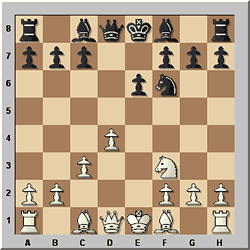
GM Alexander Finkel writes: “As I mentioned in my previous
survey, the relatively modest move 7.c3!? has become one of the
most popular ways to meet the Rubinstein variation during the
last couple of years. Despite a general impression that Black
should be doing fine after 7...c5 which was covered extensively
in issue 111 of ChessBase Magazine, many players prefer not to
commit with an early advance of the c-pawn, opting for 7...Be7,
7...a6!?, 7...Bd6 or even 7...h6?!.
One of the greatest specialists in the French Defence in the
world, Evgeny Bareev, has opted for 7...Be7 on a couple of
occasions, so it most definitely means that this line is
playable for Black (other moves are rather rare, so we will just
refer to them very briefly)! I would say that this move is more
flexible than 7...c5, but it is probably White who enjoys its
flexibility more as he can test Black’s defensive set up with a
variety of different plans!
The way I see it, once Black has played 7...Be7 there is no
point in pushing ...c5 as quickly as possible (I mean he could
have played it on the previous move if he had wanted to), so he
should just finish the development of the pieces by 0-0, b6 and
Bb7. In the meantime White may build up a menacing attacking
line-up with Bd3, Qe2, Bg5 and 0-0-0, planning to break through
on the kingside. Basically Black’s counterplay on the queenside
is considerably slower, but in most cases he may use the open
d-file in order to initiate a trade of the major pieces and
reduce White’s attacking potential.
It seems that White should be slightly better both after the
sharp 0-0-0 and the less aggressive 0-0, but I believe Black has
sufficient counter-chances in both cases.”
The author’s conclusion after extensive analysis: “In spite of a
number of promising options, I failed to find a line with a
steady opening advantage. It seems that Black is relatively safe
after 7...Be7, so the overwhelming popularity of 7...c5 is no
more than a fashion. As for the concrete lines which I consider
the most promising, I would point out 8.Bd3 c5 9.Ne5 as an
interesting try to pose Black problems. Another line which looks
rather appealing to me is a plan with 8.Be3 and queenside
castling. The plans with kingside castling by White are not very
dangerous for Black, but if I had to recommend one I would most
definitely go for Bf4.”
Content of the attached database: 1) 64 games played in this
line. Most of the games have been played during the last couple
of years. On the white side you will find such strong players as
Shirov, Adams, Grischuk, Volokitin, Motylev and many others who
have used this variation occasionally. As usual, on the black
side you will find quite a few experts in the French Defence:
Bareev, Morozevich, Short, Baklan, Noguieras. 2) 21 annotated
games (15 of them exclusively for this database). 3) A very deep
opening key designed especially for the database to make the
learning process more efficient.
C40: Elephant Gambit
In the previous issue of ChessBase Magazine the starting point
of Peter Leisebein’s comments was the position after the moves
1.e4 e5 2.Nf3 d5 3.exd5 e4:
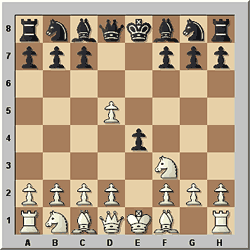
Black presses forward at once with his e-pawn and burns his
bridges behind him! 4.Qe2! Nf6. White can get rid of the
kamikaze pawn at once with 5.Nc3, but this runs into tactical
problems. White achieves no advantage by doing so!
According to theory, after 1.e4 e5 2.Nf3 d5 3.exd5 e4 4.Qe2 Nf6
5.d3!
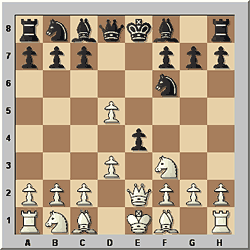
The last move is almost to be seen as a refutation. But if you
look at the statistics for games played during the last 12 years,
you get quite a different impression! An exciting position has
arisen. Black is threatening to castle quickly and to install a
rook on the e-file. White on the other hand cannot bring his
king to safety so quickly since the queen is blocking the bishop.
On the other hand, there is the threat of dxe4 and White is two
pawns up.
Black has three possible ways of developing his bishop in order
to speed up the development of his kingside:
Develop it on e7. The disadvantage of this natural developing
move is that Black now blocks his own e-file.
Develop it on c5. This possibility looks better, since the
bishop is more active and the e-file is not blocked. In the game
Buchmann,H - Leisebein,P I soon managed quite a spectacular
liquidation to a draw.
Develop it on b4. This move is aimed at castling without wasting
any time, according to F. Gutmayer’s “snappy tempo”. Tactically
speaking, it is fully justified, but the procedure has
positional shadow sides!
So the development of Black’s bishop appears to give an
advantage to White, but there is probably a very good way to get
a level game. I have been experimenting quite successfully with
the move 5...Qxd5!?. In Konikowski and Gupta’s book, this move
is described as doubtful. But I consider it to be the best reply
for Black!
This is the last of a series of eight articles by the author on
the Elephant Gambit that appeared in ChessBase Magazine. “I hope
that I have managed to provide some stimulation for adventurous
players who are not afraid of taking some risks,” Leisebein
writes. “Some final evaluations cannot yet be made. In 1994
Konikowski and Gupta published their book and database about the
Elephant Gambit. The least one can say is that a lot has
happened in this opening over the last 12 years! I can but
heartily recommend this opening to all those players who love
fighting chess.”